2016 NISSAN VERSA SEDAN fuel cap
[x] Cancel search: fuel capPage 316 of 386
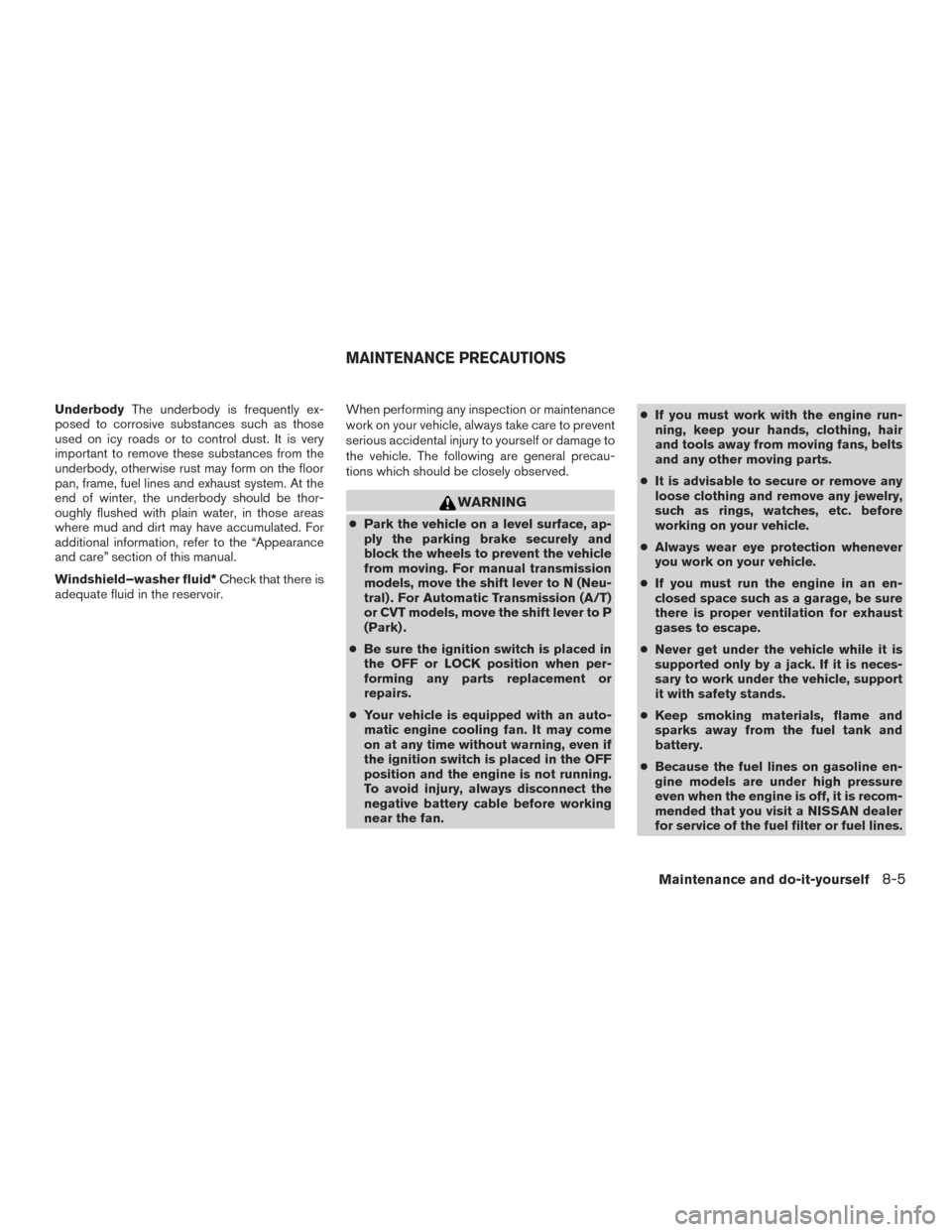
UnderbodyThe underbody is frequently ex-
posed to corrosive substances such as those
used on icy roads or to control dust. It is very
important to remove these substances from the
underbody, otherwise rust may form on the floor
pan, frame, fuel lines and exhaust system. At the
end of winter, the underbody should be thor-
oughly flushed with plain water, in those areas
where mud and dirt may have accumulated. For
additional information, refer to the “Appearance
and care” section of this manual.
Windshield–washer fluid* Check that there is
adequate fluid in the reservoir. When performing any inspection or maintenance
work on your vehicle, always take care to prevent
serious accidental injury to yourself or damage to
the vehicle. The following are general precau-
tions which should be closely observed.
WARNING
●
Park the vehicle on a level surface, ap-
ply the parking brake securely and
block the wheels to prevent the vehicle
from moving. For manual transmission
models, move the shift lever to N (Neu-
tral) . For Automatic Transmission (A/T)
or CVT models, move the shift lever to P
(Park) .
● Be sure the ignition switch is placed in
the OFF or LOCK position when per-
forming any parts replacement or
repairs.
● Your vehicle is equipped with an auto-
matic engine cooling fan. It may come
on at any time without warning, even if
the ignition switch is placed in the OFF
position and the engine is not running.
To avoid injury, always disconnect the
negative battery cable before working
near the fan. ●
If you must work with the engine run-
ning, keep your hands, clothing, hair
and tools away from moving fans, belts
and any other moving parts.
● It is advisable to secure or remove any
loose clothing and remove any jewelry,
such as rings, watches, etc. before
working on your vehicle.
● Always wear eye protection whenever
you work on your vehicle.
● If you must run the engine in an en-
closed space such as a garage, be sure
there is proper ventilation for exhaust
gases to escape.
● Never get under the vehicle while it is
supported only by a jack. If it is neces-
sary to work under the vehicle, support
it with safety stands.
● Keep smoking materials, flame and
sparks away from the fuel tank and
battery.
● Because the fuel lines on gasoline en-
gine models are under high pressure
even when the engine is off, it is recom-
mended that you visit a NISSAN dealer
for service of the fuel filter or fuel lines.
MAINTENANCE PRECAUTIONS
Maintenance and do-it-yourself8-5
Page 356 of 386
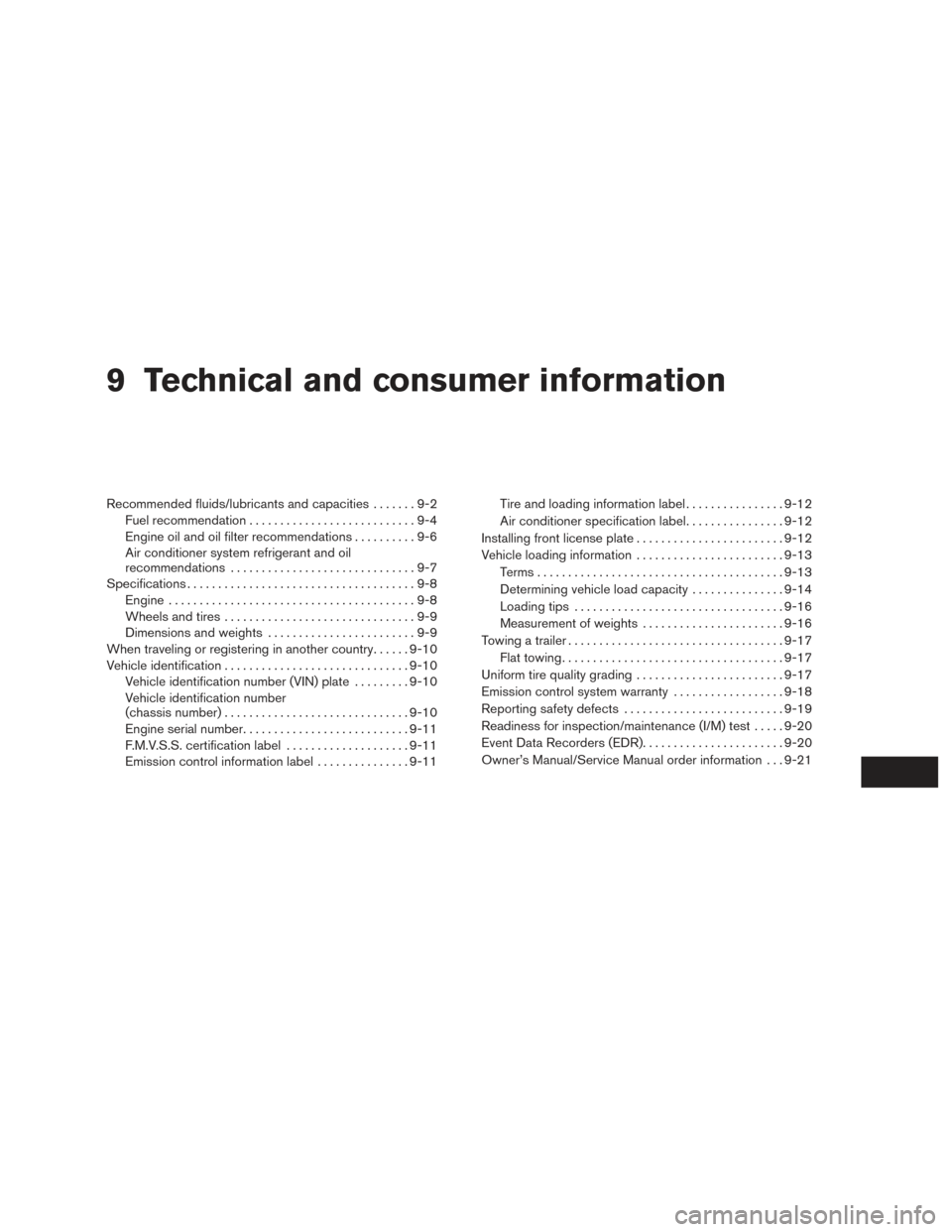
9 Technical and consumer information
Recommended fluids/lubricants and capacities.......9-2
Fuel recommendation ...........................9-4
Engine oil and oil filter recommendations ..........9-6
Air conditioner system refrigerant and oil
recommendations ..............................9-7
Specifications .....................................9-8
Engine ........................................9-8
Wheels and tires ...............................9-9
Dimensions and weights ........................9-9
When traveling or registering in another country ......9-10
Vehicle identification .............................. 9-10
Vehicle identification number (VIN) plate .........9-10
Vehicle identification number
(chassis number) .............................. 9-10
Engine serial number ........................... 9-11
F.M.V.S.S. certification label ....................9-11
Emission control information label ...............9-11Tire and loading information label
................9-12
Air conditioner specification label ................9-12
Installing front license plate ........................9-12
Vehicle loading information ........................9-13
Terms ........................................ 9-13
Determining vehicle load capacity . . .............9-14
Loading tips .................................. 9-16
Measurement of weights .......................9-16
Towing a trailer ................................... 9-17
Flat towing .................................... 9-17
Uniform tire quality grading ........................9-17
Emission control system warranty ..................9-18
Reporting safety defects .......................... 9-19
Readiness for inspection/maintenance (I/M) test .....9-20
Event Data Recorders (EDR) .......................9-20
Owner’s Manual/Service Manual order information . . . 9-21
Page 357 of 386
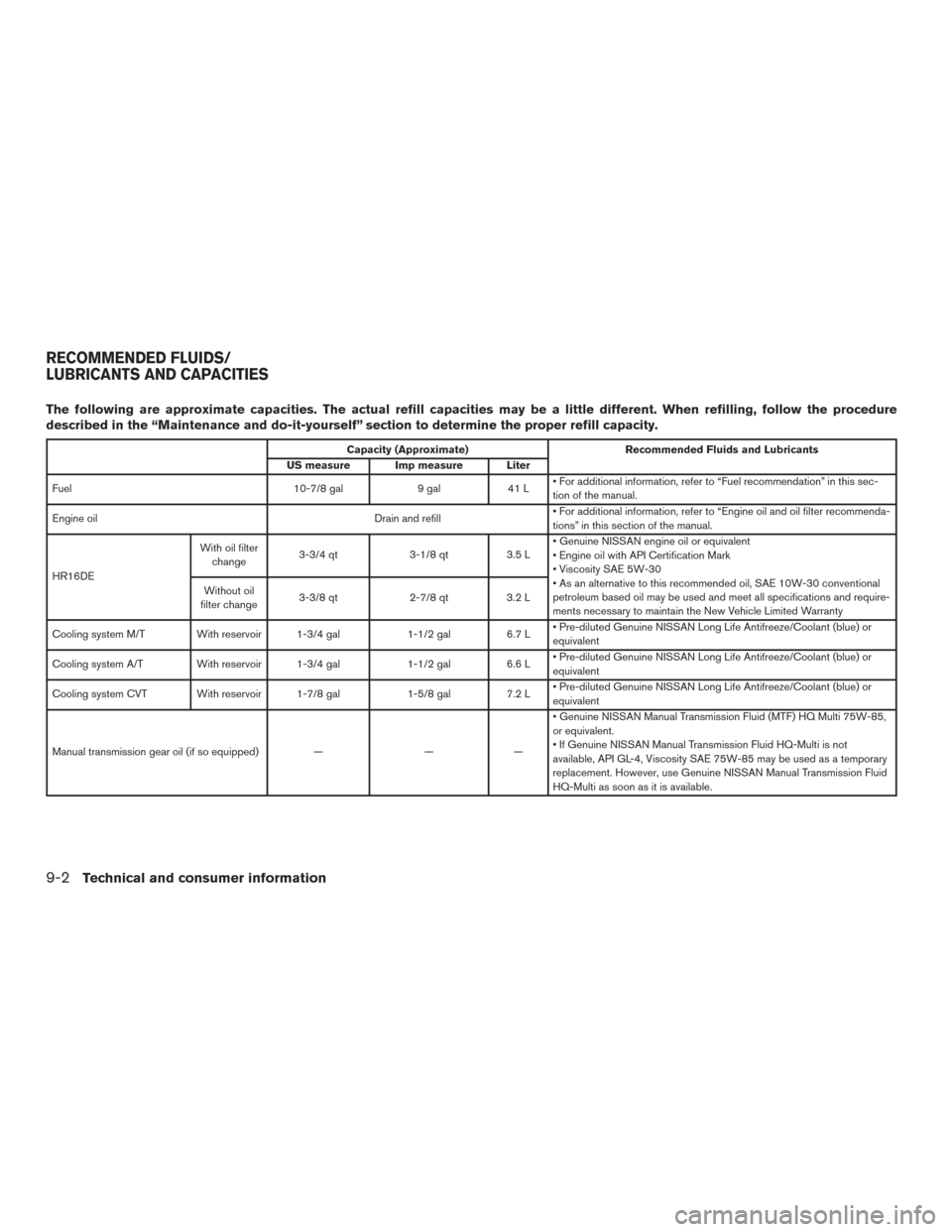
The following are approximate capacities. The actual refill capacities may be a little different. When refilling, follow the procedure
described in the “Maintenance and do-it-yourself” section to determine the proper refill capacity.
Capacity (Approximate)Recommended Fluids and Lubricants
US measure Imp measure Liter
Fuel 10-7/8 gal9 gal41 L• For additional information, refer to “Fuel recommendation” in this sec-
tion of the manual.
Engine oil Drain and refill• For additional information, refer to “Engine oil and oil filter recommenda-
tions” in this section of the manual.
HR16DE With oil filter
change 3-3/4 qt
3-1/8 qt3.5 L• Genuine NISSAN engine oil or equivalent
• Engine oil with API Certification Mark
• Viscosity SAE 5W-30
• As an alternative to this recommended oil, SAE 10W-30 conventional
petroleum based oil may be used and meet all specifications and require-
ments necessary to maintain the New Vehicle Limited Warranty
Without oil
filter change 3-3/8 qt
2-7/8 qt3.2 L
Cooling system M/T With reservoir 1-3/4 gal 1-1/2 gal6.7 L• Pre-diluted Genuine NISSAN Long Life Antifreeze/Coolant (blue) or
equivalent
Cooling system A/T With reservoir 1-3/4 gal 1-1/2 gal6.6 L• Pre-diluted Genuine NISSAN Long Life Antifreeze/Coolant (blue) or
equivalent
Cooling system CVT With reservoir 1-7/8 gal 1-5/8 gal7.2 L• Pre-diluted Genuine NISSAN Long Life Antifreeze/Coolant (blue) or
equivalent
Manual transmission gear oil (if so equipped) ———• Genuine NISSAN Manual Transmission Fluid (MTF) HQ Multi 75W-85,
or equivalent.
• If Genuine NISSAN Manual Transmission Fluid HQ-Multi is not
available, API GL-4, Viscosity SAE 75W-85 may be used as a temporary
replacement. However, use Genuine NISSAN Manual Transmission Fluid
HQ-Multi as soon as it is available.
RECOMMENDED FLUIDS/
LUBRICANTS AND CAPACITIES
9-2Technical and consumer information
Page 361 of 386

Incorrect ignition timing may result in spark
knock, after-run and/or overheating, which may
cause excessive fuel consumption or engine
damage. If any of the above symptoms are en-
countered, have your vehicle checked. It is rec-
ommended that you visit a NISSAN dealer for
servicing.
However, now and then you may notice
light spark knock for a short time while
accelerating or driving up hills. This is not a
cause for concern, because you get the
greatest fuel benefit when there is light
spark knock for a short time under heavy
engine load.
ENGINE OIL AND OIL FILTER
RECOMMENDATIONS
Selecting the correct oil
It is essential to choose the correct grade, quality
and viscosity engine oil to ensure satisfactory
engine life and performance. For additional infor-
mation, refer to “Recommended fluids/lubricants
and capacities” in this section. NISSAN recom-
mends the use of an energy conserving oil in
order to improve fuel economy.
Select only engine oils that meet the American
Petroleum Institute (API) certification or Interna-
tional Lubricant Standardization and ApprovalCommittee (ILSAC) certification and SAE vis-
cosity standard. These oils have the API certifica-
tion mark on the front of the container. Oils which
do not have the specified quality label should not
be used as they could cause engine damage.Oil additives
NISSAN does not recommend the use of oil
additives. The use of an oil additive is not neces-
sary when the proper oil type is used and main-
tenance intervals are followed.
Oil which may contain foreign matter or has been
previously used should not be used.
LTI2061
9-6Technical and consumer information
Page 379 of 386
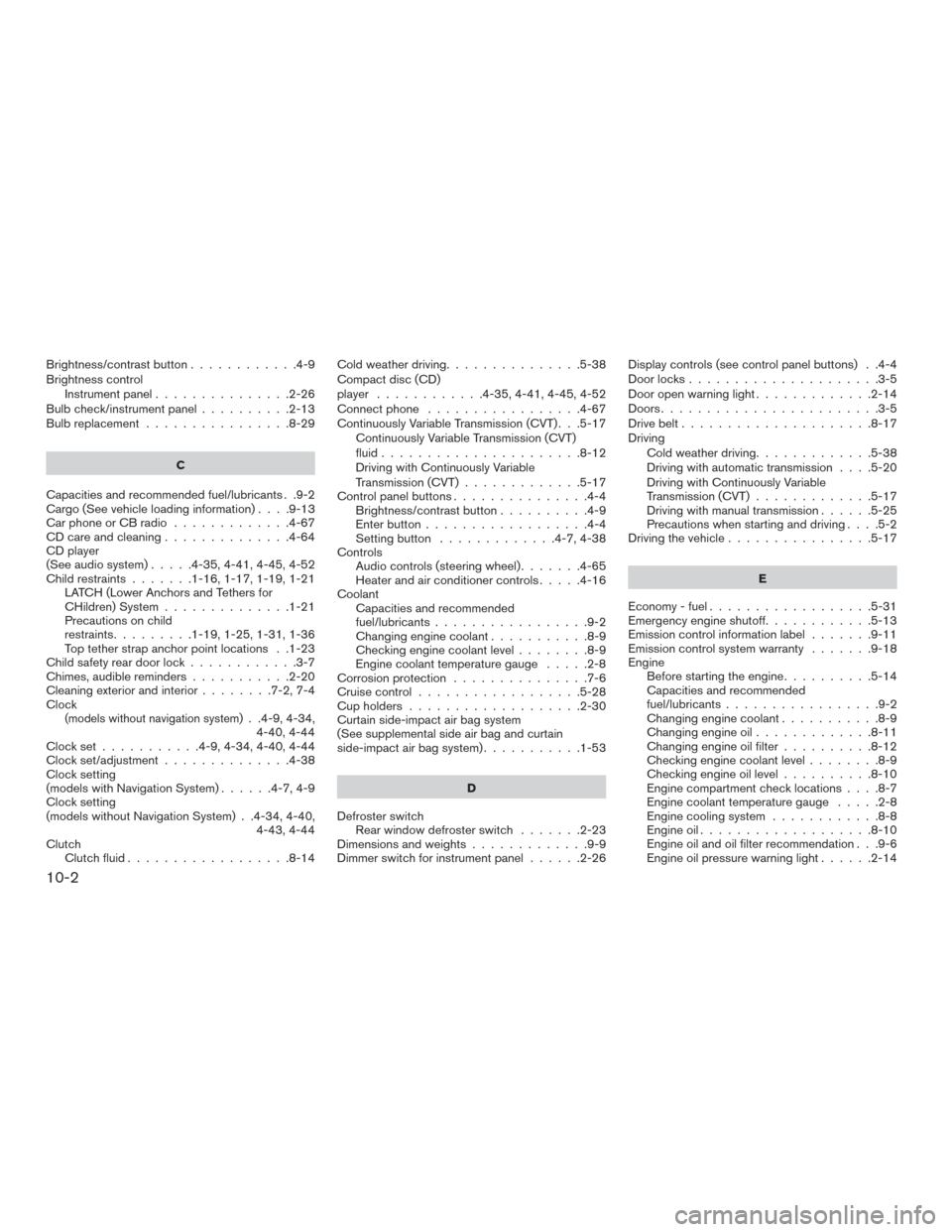
Brightness/contrastbutton............4-9
Brightness controlInstrument panel ...............2-26
Bulb check/instrument panel ..........2-13
Bulb replacement ................8-29
C
Capacities and recommended fuel/lubricants . .9-2
Cargo(Seevehicleloadinginformation)....9-13
Car phone or CB radio .............4-67
CD care and cleaning ..............4-64
CD player
(See audio system) .....4-35,4-41,4-45,4-52
Child restraints .......1-16,1-17,1-19,1-21
LATCH (Lower Anchors and Tethers for
CHildren) System ..............1-21
Precautions on child
restraints.........1-19,1-25,1-31,1-36
Top tether strap anchor point locations . .1-23
Child safety rear door lock ............3-7
Chimes, audible reminders ...........2-20
Cleaningexteriorandinterior........7-2,7-4
Clock
(models without navigation system). .4-9, 4-34, 4-40, 4-44
Clockset...........4-9,4-34,4-40,4-44
Clock set/adjustment ..............4-38
Clock setting
(models with Navigation System) ......4-7,4-9
Clock setting
(models without Navigation System) . .4-34, 4-40, 4-43, 4-44
Clutch Clutch fluid ..................8-14 Cold weather driving
...............5-38
Compact disc (CD)
player ............4-35,4-41,4-45,4-52
Connect phone .................4-67
Continuously Variable Transmission (CVT) . . .5-17 Continuously Variable Transmission (CVT)
fluid......................8-12
Driving with Continuously Variable
Transmission (CVT) .............5-17
Control panel buttons ...............4-4
Brightness/contrast button ..........4-9
Enterbutton..................4-4
Setting button .............4-7,4-38
Controls Audio controls (steering wheel) .......4-65
Heater and air conditioner controls .....4-16
Coolant Capacities and recommended
fuel/lubricants .................9-2
Changingenginecoolant...........8-9
Checking engine coolant level ........8-9
Engine coolant temperature gauge .....2-8
Corrosion protection ...............7-6
Cruisecontrol..................5-28
Cupholders...................2-30
Curtain side-impact air bag system
(See supplemental side air bag and curtain
side-impact air bag system) ...........1-53
D
Defroster switch Rear window defroster switch .......2-23
Dimensionsandweights.............9-9
Dimmer switch for instrument panel ......2-26Display controls (see control panel buttons) . .4-4
Door locks
.....................3-5
Door open warning light .............2-14
Doors ........................3-5
Drive belt .....................8-17
Driving Cold weather driving .............5-38
Driving with automatic transmission ....5-20
Driving with Continuously Variable
Transmission (CVT) .............5-17
Driving with manual transmission ......5-25
Precautions when starting and driving ....5-2
Driving the vehicle ................5-17
E
Economy-fuel..................5-31
Emergency engine shutoff ............5-13
Emission control information label .......9-11
Emission control system warranty .......9-18
Engine Before starting the engine ..........5-14
Capacities and recommended
fuel/lubricants.................9-2
Changing engine coolant ...........8-9
Changingengineoil.............8-11
Changing engine oil filter ..........8-12
Checking engine coolant level ........8-9
Checking engine oil level ..........8-10
Engine compartment check locations ....8-7
Engine coolant temperature gauge .....2-8
Engine cooling system ............8-8
Engineoil...................8-10
Engine oil and oil filter recommendation . . .9-6
Engine oil pressure warning light ......2-14
10-2
Page 380 of 386
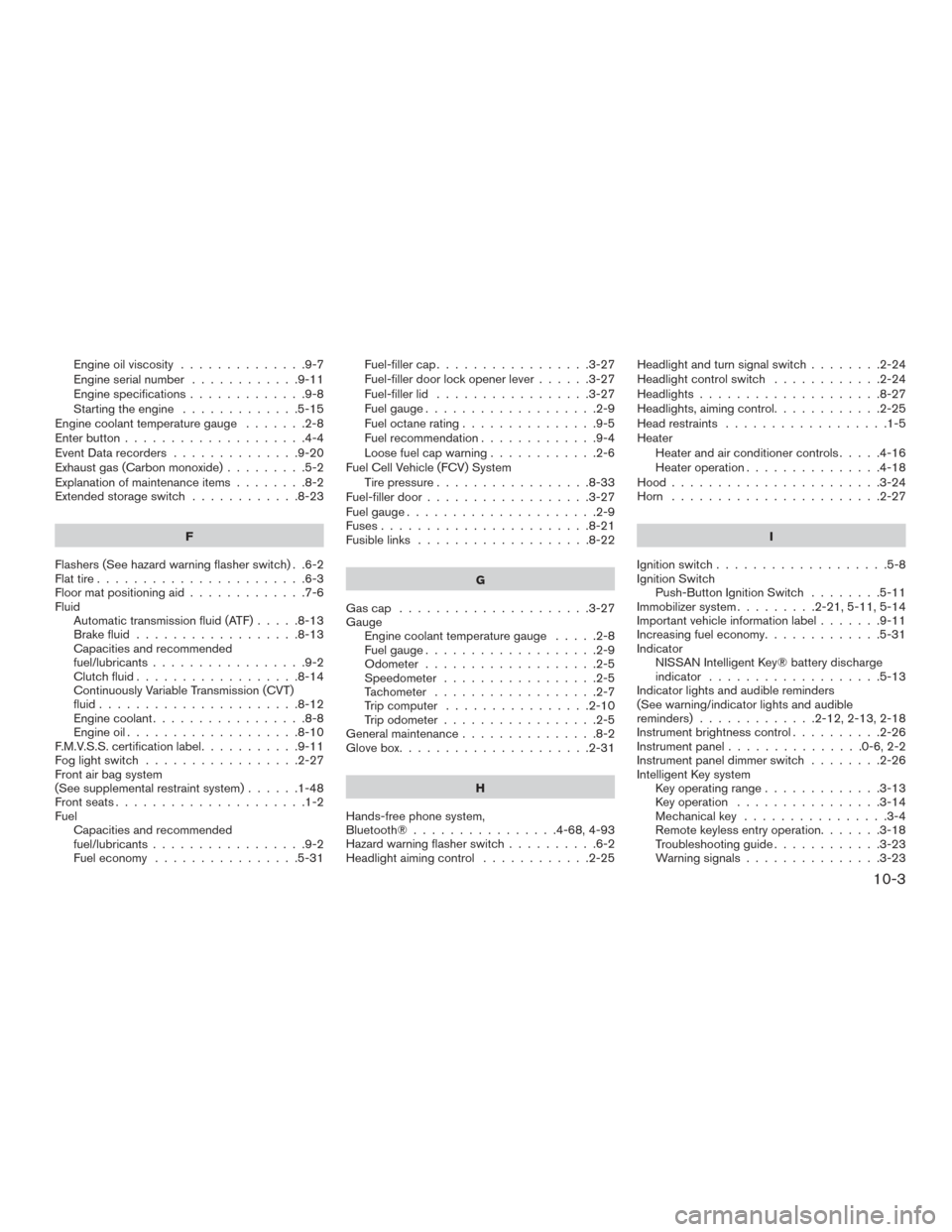
Engine oil viscosity..............9-7
Engine serial number ............9-11
Engine specifications .............9-8
Starting the engine .............5-15
Engine coolant temperature gauge .......2-8
Enterbutton....................4-4
Event Data recorders ..............9-20
Exhaust gas (Carbon monoxide) .........5-2
Explanation of maintenance items ........8-2
Extendedstorageswitch ............8-23
F
Flashers (See hazard warning flasher switch) . .6-2
Flat tire .......................6-3
Floor mat positioning aid .............7-6
Fluid Automatic transmission fluid (ATF) .....8-13
Brake fluid ..................8-13
Capacities and recommended
fuel/lubricants .................9-2
Clutchfluid..................8-14
Continuously Variable Transmission (CVT)
fluid......................8-12
Engine coolant .................8-8
Engine oil ...................8-10
F.M.V.S.S. certification label ...........9-11
Foglightswitch .................2-27
Front air bag system
(See supplemental restraint system) ......1-48
Frontseats.....................1-2
Fuel Capacities and recommended
fuel/lubricants .................9-2
Fuel economy ................5-31 Fuel-filler cap
.................3-27
Fuel-filler door lock opener lever ......3-27
Fuel-filler lid .................3-27
Fuel gauge ...................2-9
Fuel octane rating ...............9-5
Fuel recommendation .............9-4
Loose fuel cap warning ............2-6
Fuel Cell Vehicle (FCV) System Tirepressure.................8-33
Fuel-filler door ..................3-27
Fuelgauge.....................2-9
Fuses.......................8-21
Fusiblelinks ...................8-22
G
Gascap .....................3-27
Gauge Engine coolant temperature gauge .....2-8
Fuel gauge ...................2-9
Odometer ...................2-5
Speedometer .................2-5
Tachometer ..................2-7
Trip computer ................2-10
Trip odometer .................2-5
General maintenance ...............8-2
Glovebox.....................2-31
H
Hands-free phone system,
Bluetooth®................4-68,4-93
Hazard warning flasher switch ..........6-2
Headlight aiming control ............2-25 Headlightandturnsignalswitch........2-24
Headlightcontrolswitch ............2-24
Headlights....................8-27
Headlights, aiming control
............2-25
Head restraints ..................1-5
Heater Heater and air conditioner controls .....4-16
Heater operation ...............4-18
Hood.......................3-24
Horn .......................2-27
I
Ignition switch................... 5
-8
Ignition Switch Push-Button Ignition Switch ........5-11
Immobilizer system .........2-21,5-11,5-14
Important vehicle information label .......9-11
Increasing fuel economy .............5-31
Indicator NISSAN Intelligent Key® battery discharge
indicator ...................5-13
Indicator lights and audible reminders
(See warning/indicator lights and audible
reminders).............2-12,2-13,2-18
Instrument brightness control ..........2-26
Instrumentpanel...............0-6,2-2
Instrument panel dimmer switch ........2-26
Intelligent Key system Key operating range .............3-13
Key operation ................3-14
Mechanical key ................3-4
Remote keyless entry operation.......3-18
Troubleshooting guide ............3-23
Warning signals ...............3-23
10-3
Page 381 of 386
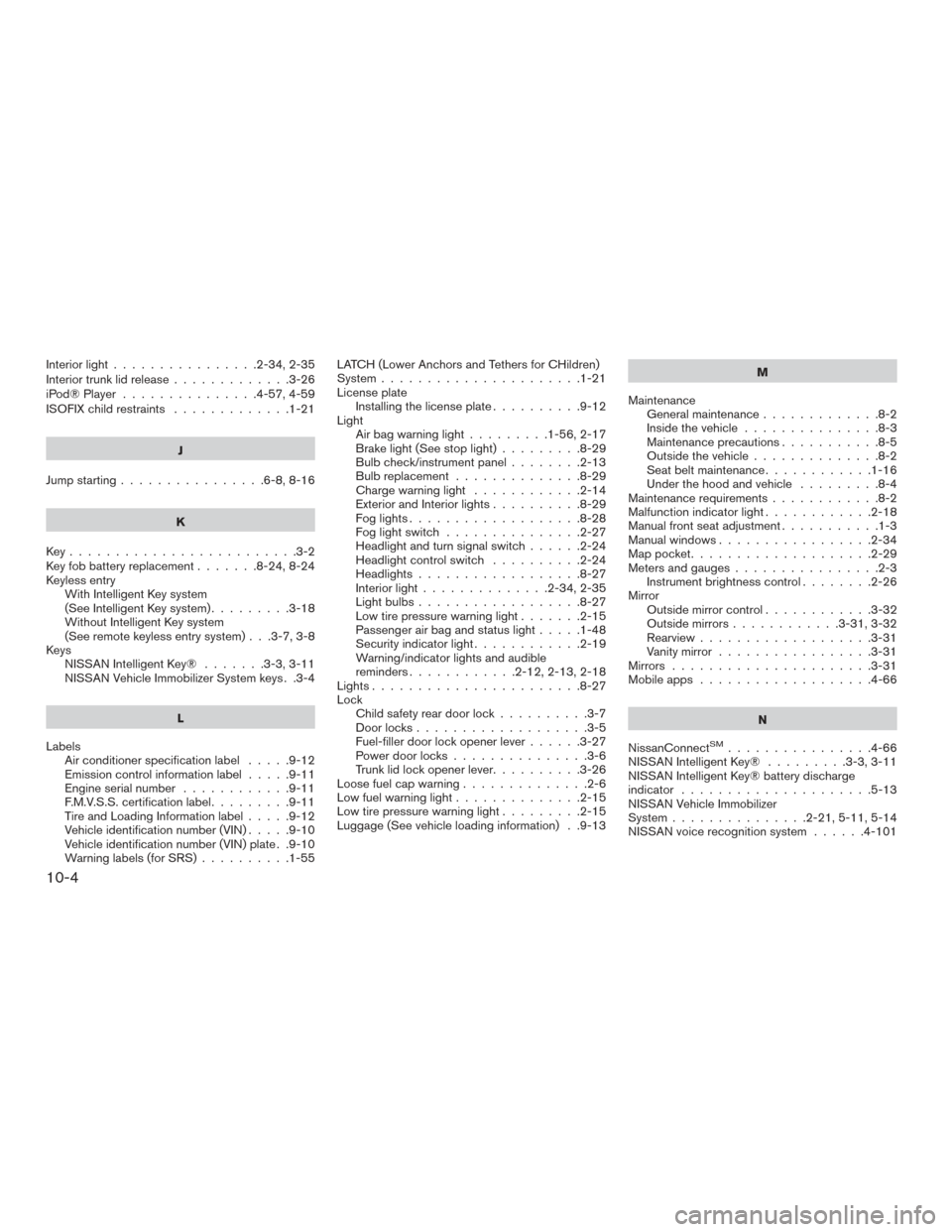
Interiorlight................2-34,2-35
Interiortrunklidrelease.............3-26
iPod®Player ...............4-57,4-59
ISOFIX child restraints.............1-21
J
Jump starting ................6-8,8-16
K
Key.........................3-2
Key fob battery replacement .......8-24,8-24
Keyless entry With Intelligent Key system
(See Intelligent Key system) .........3-18
Without Intelligent Key system
(See remote keyless entry system) . . .3-7, 3-8
Keys NISSAN Intelligent Key® .......3-3,3-11
NISSAN Vehicle Immobilizer System keys . .3-4
L
Labels Air conditioner specification label .....9-12
Emissioncontrolinformationlabel.....9-11
Engine serial number ............9-11
F.M.V.S.S. certification label .........9-11
Tire and Loading Information label .....9-12
Vehicle identification number (VIN) .....9-10
Vehicle identification number (VIN) plate . .9-10
Warning labels (for SRS) ..........1-55LATCH (Lower Anchors and Tethers for CHildren)
System
......................1-21
License plate Installing the license plate ..........9-12
Light Air bag warning light .........1-56,2-17
Brake light (See stop light) .........8-29
Bulb check/instrument panel ........2-13
Bulbreplacement..............8-29
Charge warning light ............2-14
Exterior and Interior lights ..........8-29
Foglights...................8-28
Foglightswitch ...............2-27
Headlight and turn signal switch ......2-24
Headlight control switch ..........2-24
Headlights..................8-27
Interiorlight..............2-34,2-35
Lightbulbs..................8-27
Low tire pressure warning light .......2-15
Passenger air bag and status light .....1-48
Security indicator light ............2-19
Warning/indicator lights and audible
reminders ............2-12,2-13,2-18
Lights.......................8-27
Lock Child safety rear door lock ..........3-7
Door locks ...................3-5
Fuel-filler door lock opener lever ......3-27
Power door locks ...............3-6
Trunk lid lock opener lever ..........3-26
Loose fuel cap warning ..............2-6
Lowfuelwarninglight..............2-15
Low tire pressure warning light .........2-15
Luggage (See vehicle loading information) . .9-13 M
Maintenance General maintenance .............8-2
Insidethevehicle...............8-3
Maintenance precautions ...........8-5
Outside the vehicle ..............8-2
Seat belt maintenance ............1-16
Under the hood and vehicle .........8-4
Maintenance requirements ............8-2
Malfunction indicator light ............2-18
Manual front seat adjustment ...........1-3
Manual windows .................2-34
Mappocket....................2-29
Meters and gauges ................2-3
Instrument brightness control ........2-26
Mirror Outside mirrorcontrol ............
3-32
Outside mirrors ............3-31,3-32
Rearview ...................3-31
Vanity mirror .................3-31
Mirrors ......................3-31
Mobileapps ...................4-66
N
NissanConnect
SM................4-66
NISSAN Intelligent Key® .........3-3,3-11
NISSAN Intelligent Key® battery discharge
indicator .....................5-13
NISSAN Vehicle Immobilizer
System ...............2-21,5-11,5-14
NISSAN voice recognition system ......4-101
10-4
Page 382 of 386
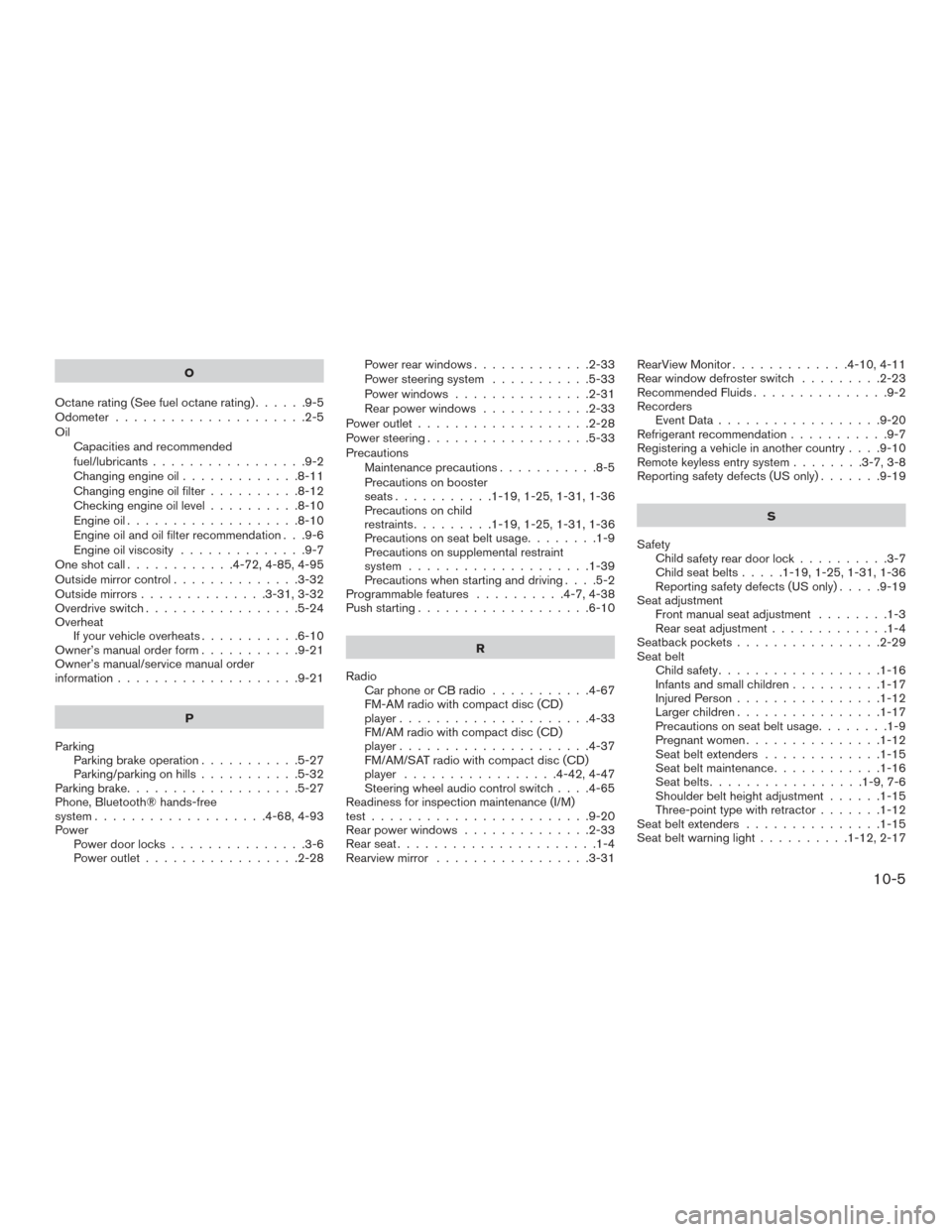
O
Octanerating(Seefueloctanerating)......9-5
Odometer .....................2-5
Oil Capacities and recommended
fuel/lubricants .................9-2
Changing engine oil .............8-11
Changing engine oil filter ..........8-12
Checking engine oil level ..........8-10
Engine oil ...................8-10
Engine oil and oil filter recommendation . . .9-6
Engine oil viscosity ..............9-7
Oneshotcall............4-72,4-85,4-95
Outside mirror control ..............3-32
Outside mirrors ..............3-31,3-32
Overdrive switch .................5-24
Overheat Ifyourvehicleoverheats...........6-10
Owner’s manual order form ...........9-21
Owner’s manual/service manual order
information ....................9-21
P
Parking Parking brake operation ...........5-27
Parking/parking on hills ...........5-32
Parking brake ...................5-27
Phone, Bluetooth® hands-free
system ...................4-68,4-93
Power Power door locks ...............3-6
Power outlet .................2-28 Power rear windows
.............2-33
Power steering system ...........5-33
Power windows ...............2-31
Rear power windows ............2-33
Power outlet ...................2-28
Power steering ..................5-33
Precautions Maintenance precautions ...........8-5
Precautions on booster
seats...........1-19,1-25,1-31,1-36
Precautions on child
restraints .........1-19,1-25,1-31,1-36
Precautions on seat belt usage ........1-9
Precautions on supplemental restraint
system ....................1-39
Precautions when starting and driving ....5-2
Programmablefeatures ..........4-7,4-38
Push starting ...................6-10
R
Radio Car phone or CB radio ...........4-67
FM-AM radio with compact disc (CD)
player .....................4-33
FM/AM radio with compact disc (CD)
player .....................4-37
FM/AM/SAT radio with compact disc (CD)
player .................4-42,4-47
Steering wheel audio control switch ....4-65
Readiness for inspection maintenance (I/M)
test........................9-20
Rear power windows ..............2-33
Rearseat......................1-4
Rearview mirror .................3-31 RearView Monitor
.............4-10,4-11
Rear window defroster switch .........2-23
Recommended Fluids ...............9-2
Recorders EventData..................9-20
Refrigerant recommendation ...........9-7
Registering a vehicle in another country ....9-10
Remote keyless entry system ........3-7,3-8
Reporting safety defects (US only) .......9-19
S
Safety Child safety rear
door lock ..........3-7
Child seat belts .....1-19,1-25,1-31,1-36
Reporting safety defects (US only) .....9-19
Seat adjustment Front manual seat adjustment ........1-3
Rear seat adjustment .............1-4
Seatbackpockets................2-29
Seat belt Child safety ..................1-16
Infants and small children ..........1-17
Injured Person ................1-12
Largerchildren................1-17
Precautions on seat belt usage ........1-9
Pregnant women ...............1-12
Seatbeltextenders .............1-15
Seatbeltmaintenance............1-16
Seatbelts.................1-9,7-6
Shoulder belt height adjustment ......1-15
Three-point type with retractor .......1-12
Seat belt extenders ...............1-15
Seatbeltwarninglight..........1-12,2-17
10-5